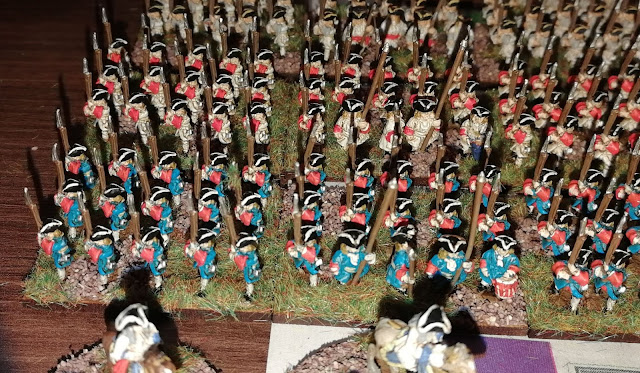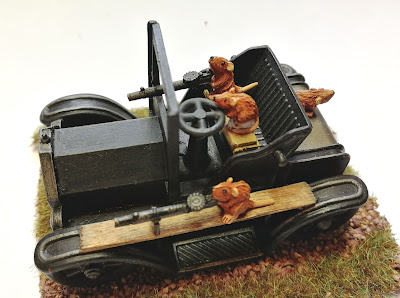Operation Osprey: The Search for Unobtainium Deposits in Darkest Africa.
A solo campaign interlinking various games and rule books from
the Osprey Wargames series
Despite being a member of a very active club, I often turn to solo wargaming; not everyone is available to play at all times after all. I wanted to play more than just random games and so devised a way to connect several into a mini campaign. I am a huge fan of the Osprey wargame titles and, with a little tweaking, created an entertaining and workable system using three of them - The Lost Expedition card based game (LE), The Men Who Would Be Kings (MWWBK) and In Her Majesties Name (IHMN). Each would be played in the above order with figure losses and the results of each having an effect on the next.
 |
| The three games and the reason behind the title, Operation Osprey! |
The campaign is set in Darkest Africa at the very end of the nineteenth century. The Society of Thule (a company taken from the IHMN rule book) have discovered a way of creating temporary zombies from their own fallen troops to help continue a fight. However, the effect is difficult to produce, works within limited ranges and all too quickly destroys the zombies it creates. Far better results were found using the ultra-rare mineral, Unobtainium (sorry), but so little is available and at a prohibitively high cost the project stalled.
Until that was, a paper was published by the Royal Society in London. A solitary survivor of a long lost expedition to Darkest Africa had been found and, along with tales of an abandoned city and pockets full of diamonds, returned with a small figurine made entirely of the purest Unobtainium. If there was enough Unobtainium to fashion such a trinket, how much must there be in the city itself? The Society of Thule immediately funded a large military and scientific expedition to find the city and secure all the Unobtainium for themselves.
Setting up the campaign
The player takes the role of the Society of Thule. In the campaign they will be using a mix of both Thule troops from the IHMN rule book and regular infantry from the MWWBK rule book.
They should build the Thule force, including the characters Von Stronheim and Dr Kobalt, to the recommended 250-300 points and up to twelve figures. If less than twelve figures are used then add enough regular infantry figures to make up to twelve.
 |
| The Society of Thule with extra regular infantry to make twelve figures |
The rest of the expedition is made up of three units of twelve regular infantry. In effect, the player will now have four units of twelve figures as per the MWWBK rules, making a twenty-four point, forty-eight figure modern infantry force. This is the entire expedition force available to the player and any loses taken at one point will be unavailable at the next.
 |
| The players forces including Thule troops amongst the riflemen |
The enemy forces consist of two distinct sets. Firstly, you will need a twenty four point native tribal force as per the MWWBK rule book. These are the defenders of the land the campaign is set in. Secondly, you will need a suitable IHMN force to act as shrine guards. Build this to the same number of points as you have used to build the Society of Thule force but, divide it into groups of about 50 points each. My suggestion here is to take characters directly from the rule book. My own forces for this part of the campaign are very simple. I have a giant bird that I use the Yeti stats for, two mummies without any magic forces and some fifteen native spearmen; roughly 280 points in all. The bird and each of the mummies form their own groups and I divide the native spearmen into groups of three to six figures.
 |
| The shrine guards, divided into groups of about 35/50 points |
Now assign each group a playing card from one suit and add twice the number of cards from the other suits. Warbases produce a very handy set of 30mm round playing card tokens, these are perfect for the task and can be placed amongst the terrain to represent hidden and random enemies. https://warbases.co.uk/product/playing-card-tokens/
You will, of course, also require a copy of the Lost Expedition card game.
Playing the campaign.
The Lost Expedition – Locate the lost city
 |
| Losses can mount in the jungle! |
The campaign starts with the search for the lost city and uses the Lost Expedition card game. This should be played as per the solo play section on page 10 of the games rule booklet; the game will only differ in the expeditions team members. Lay out the three team member cards as per the rule booklet but, place one of the regular infantry figures on each of the cards as well as the tokens the game rules require. These figures represent your scouts searching for the lost city. Each time a team member is lost during the game, remove the figure too. This figure will no longer be available for the rest of the campaign. In the Lost Expedition game itself, once a player loses all three of the team the game is over. However, in this campaign it means that these particular troops have been lost and you must then send out three new troops to find where the others got to and continue the search. When this happens, rather than start the game all over again (which you can of course, it’s your campaign after all) simply go back one card (day) on the nine card Expedition track, and begin again from that point. Once you complete the game by reaching the Lost City, this phase of the campaign is over. Any and all figure loses are packed away, any figure still alive is returned to your campaign forces and you will move on to the next phase. Note that you may not now have the neat four units of twelve anymore!
The Men Who Would be Kings – Locate the shrine entrance
The natives of this region were not found to be cannibals although, they did have a disturbing interest in anatomy and millinery… Dr. Babbage, African Travels and Amusing Hats, London, 1837.
 |
| A tribal unit appears from nowhere, thanks Mr Babbage! |
Having found the lost city, the Society of Thule must now locate the shrine entrance where it is said the Unobtainium figurine was found. The player should organise the surviving figures from the Lost Expedition game back into four (probably now unequally sized) units. How the figures are divided between each unit is up to the player although all Society of Thule figures must be in one unit; this can again be added to with surviving regular infantry to no more than twelve figures. You may decide to take all of the casualties from the previous phase from one unit or spread them around all four. This is entirely up to you.
During this phase of the game, each of the figures representing the Society of Thule will only act as an ordinary regular infantryman. None of their special weapons are used and it is assumed they all have ordinary infantry rifles. If one of the societies Fusilier figures depicted with a revivifier is killed, it should be replaced with one of the Tod-truppen zombie figures. Such a figure cannot shoot so this should be taken into account when that unit fires although it still counts during melee. The player may choose which figure to remove from the Thule unit when casualties are taken including any Tod-truppen.
It is suggested that where possible a 6ft x 4ft table is used and that the player’s forces start at a narrow side, fighting their way to the other narrow side. Plenty of terrain should be added and suitable shrine entrance should be placed at the far end of the table. The battle will now be fought using TMWWBK solo rules found on page 40 of that book, playing against Mr. Babbage.
The game will end when either side has been clearly defeated or, if a unit of at least THREE members of the society of Thule, including both Von Stronheim and Dr Kobalt, make it to the shrine entrance. If this happens, the defenders will lose heart and disappear. The campaign is lost if the Society of Thule unit is destroyed or if either Von Stronheim or Dr Kobalt are killed.
In Her Majesties Name – Into the darkness
 |
| Dr Kobalt reaches the Altar |
In this final phase of the campaign, the Society of Thule has located the entrance to the shrine and will now search for the Unobtainium. Only the surviving members of the Society of Thule take part in this game, none of the regular infantry; they have done their job. The game continues using the rules as per IHMN and all the societies’ special weapons are back in play again.
In order to make this playable as a solo game, there needs to be a little engineering to bring some randomness. The player should lay out a playing surface roughly 3ft x 3ft and add enough pieces of impassable and sight blocking terrain to make it impossible to move directly from edge to edge. In effect it should look somewhat maze like. The player will need to move the Society of Thule from the centre of the edge with the shrine entrance to the centre of the opposite edge. Here there will be an altar upon which will be the source of the Unobtainium! After spending a full turn at the altar, the Society must then make it back to the shrine entrance with at least Dr Kobalt alive. Do this and the Player will have won the campaign. However, and in true Hollywood action movie fashion, each time the Society pass between two terrain pieces that passage is immediately blocked behind them; meaning they can never go back the way they came.
Of course, the shrine is defended. At the start of the game, randomly place the card tokens face down throughout the playing area. Each time a member of the Society party comes within two inches of a token, turn it over. If the token represents part of the shrine guard force, place the corresponding figures between the altar and the Society, six inches from the figure that triggered the token. The shrine guards are always hostile and will always try to melee with the Society until killed.
So there you have it, a mini solo campaign using readily available resources. None of this is set in stone of course. You must feel free to tailor the system to whatever you have available or takes your fancy; different forces or settings, different order. The point is, it is possible to play more than just one-off games as a solo wargamer.




























